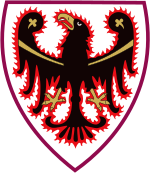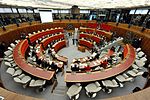Trentino Parliament
| Coat of arms of Trentino | Boardroom |
|---|---|

|

|
| Basic data | |
| Seat: | Official building of the Autonomous Region of Trentino-South Tyrol in Trento |
| Legislative period : | five years |
| First session: | 1972 |
| MPs: | 35 |
| Current legislative period | |
| Last choice: | October 21, 2018 |
| Next choice: | 2023 |
| Distribution of seats: |
Government (21)
|
| Website | |
| www.consiglio.provincia.tn.it | |
The Diet of Trentino ( Consiglio della Provincia autonoma di Trento in Italian ) is the legislative body of the Autonomous Province of Trento . It consists of 35 seats and since the passage and entry into force of the Second Statute of Autonomy of 1971/72 has just as extensive legislative powers as the state parliament in neighboring South Tyrol . Its conference venue is in the official building of the Autonomous Region of Trentino-South Tyrol in Trento .
Historical ties to the regional council of Trentino-South Tyrol
The members of the Trentino Parliament and the South Tyrol Parliament together form the regional council for the Trentino-South Tyrol region . Formal legal were together with 1948-1998 South Tyrol Regional Council elections for the Regional Council of Trentino-Alto Adige held from then the two diets were occupied by the Trentino and South Tyrol. Since the Italian constitutional reform in 2001, the logic has been reversed: the provincial parliaments of Trentino and South Tyrol are now elected separately and then together form the regional council.
This reversal primarily takes account of the shift in competences that, since the adoption (1971) and entry into force (1972) of the Second Statute of Autonomy, has shifted most of the legislative competences from the regional council to the two state parliaments, which greatly diminished the institutional importance of the formerly important regional council. In comparison with other regional parliaments in Italy , but also in comparison with the state parliaments in neighboring Austria , the state parliaments of Trentino and South Tyrol can regulate a relatively large number of areas of competence with their own state laws.
Institutional tasks
As part of the institutional separation of powers , the Landtag has the task - in addition to its legislative activity - to elect the Trentino Provincial Government (Giunta provinciale) with an absolute majority . Within the framework of the state laws passed by the state parliament, this is authorized to issue ordinances that ensure the concrete implementation of the state laws.
The state parliament controls the activities of the state government through parliamentary questions ( interpellation ) to individual members of the state government, through the establishment of control committees for specific issues and last but not least through the adoption of the annual state budget, with which the Trentino state government has the necessary funds to carry out its activities Will be provided.
Suffrage
The right to vote is regulated in State Law No. 2 of March 5, 2003. According to Article 12, all citizens who have reached the age of 18 on the day of the election, are on the electoral roll and have been resident in the Autonomous Province of Trento for at least one year without interruption are entitled to vote.
The right to vote provides for the direct election of the governor . The latter is supported by a list or an electoral alliance of several lists. Every voter has a list vote. In addition, up to two preferential votes can be cast for the candidates on the same list, which was also given the list vote. When casting two preferential votes, one vote must fall on one candidate and one candidate. If two same-sex preferential votes are cast, the second vote will be considered invalid.
The candidate who has received most of the valid list votes is elected as governor. The list or lists of the victorious electoral alliance automatically receive, in proportion to the votes received, at least 17 of 35 Landtag seats plus one seat for the Governor. If the governor's candidate has received more than 40% of the list votes, the lists that support him receive 20 seats in the provincial parliament plus one seat for the governor. Regardless of the actual distribution of votes, the opposition has at least 11 seats in the state parliament. In return, the winning list or electoral alliance has a maximum of 24 seats, 23 members of the state parliament and one governor. A seat in the state parliament is automatically assigned to the list most elected in the Ladin-speaking municipalities, namely the candidate with the most preferences.
See also
literature
- Autonomous Region Trentino-Alto Adige / Autonomous Province Bolzano / Autonomous Province Trento (Ed.): The legislative bodies and the governments from the 1st to the 14th legislative period . (PDF) BQE Edizioni, Bozen / Trient 2011
Web links
- Official website (Italian)
Individual evidence
- ↑ Provincial Law No. 2 of March 5, 2003 and subsequent amendments (Italian) accessed on October 22, 2018
- ↑ Brief summary of the suffrage of the Autonomous Province of Trento (Italian), accessed on October 22, 2018